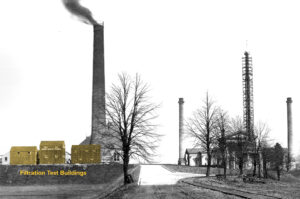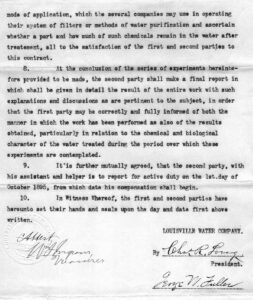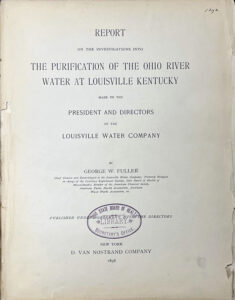On October 16, 1860, Louisville Water Company first delivered water to 512 customers. We are proud to say 163 years later, Louisville Water produces an average of 127 million gallons every day for nearly one million people.
Widely known for its high-quality and great-tasting drinking water, you might not know that Louisville Water helped pioneer the first studies into water purification and filtration.
In his quest for clean water, Louisville Water Chief Engineer Charles Hermany recruited George Warren Fuller in 1895 to oversee filtration experiments.

 The experiments took place on the same property where the Louisville Water Tower and Original Pumping Station No. 1 stand today. As chief chemist and bacteriologist, Fuller supervised the rapid sand-filtration studies while doing his own research. He concluded that settling the water in a reservoir followed by coagulation and filtration would create a cleaner water supply.
The experiments took place on the same property where the Louisville Water Tower and Original Pumping Station No. 1 stand today. As chief chemist and bacteriologist, Fuller supervised the rapid sand-filtration studies while doing his own research. He concluded that settling the water in a reservoir followed by coagulation and filtration would create a cleaner water supply.
Realizing the importance of the research, company officials decided to publish Fuller’s final report and agreed to do so by May 1, 1897. If that did not happen, Fuller would have the right to publish the report. The 1898 publication indicates that is what happened.

Several printed copies of Fuller’s final report on the filtration tests are in Louisville Water’s collections. In the introduction, Fuller said the goal of the tests was to determine “the quality of river water after purification on a practical scale by each of the filters or systems, and the collection and compilation of such data as would indicate the cost of construction and operation of these filters or systems of purification.”
Louisville Water Archive Specialist Jay Ferguson dug through historical records to learn that Louisville Water spent approximately $43,000 on the experiments. Today, that would be equivalent to roughly $1.6 million.
 The Purification of the Ohio River Water at Louisville, Kentucky includes illustrations of the filtering devices, data charts, and analyses. Along with a summary of Fuller’s findings, he shared recommendations on the best way to filter raw Ohio River water.
The Purification of the Ohio River Water at Louisville, Kentucky includes illustrations of the filtering devices, data charts, and analyses. Along with a summary of Fuller’s findings, he shared recommendations on the best way to filter raw Ohio River water.
A review by The Lancet in 1899, a peer-reviewed general medical journal, called the report “a stupendous piece of work… containing thousands of practical and experimental results relating to filtration, sedimentation, coagulation, and the degree of efficiency of the purifying processes investigated.”
Fuller’s groundbreaking work provided the scientific foundation for water filtration around the world.
More than a century later, Louisville Water’s commitment to public health and high-quality water continues. We are home to two of the top 19 water treatment plants in the country and are often considered a model in the industry.
Join us in raising a glass of Louisville Pure Tap® to say cheers to 163 years, Louisville Water!

